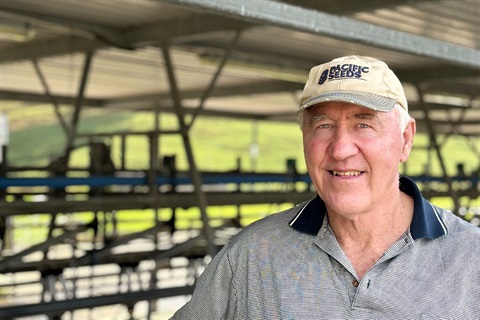Hikurangi repo gravity gate gets go-ahead
Published on 05 April 2024

The installation of a new 15 metre long floodgate (also known as a gravity gate) at Hikurangi repo will help local farmers get back onto their land faster after major floods.
The new floodgate will drain water faster during severe flood events. It will reduce our operational expenditure by around $30k-$40k per year, according to discussions coming out of the Hikurangi Repo Business Case project.
It will also offer local farmers faster relief from flooding and offer safe passage for local marine life such as long fin eels.
Generational farmer Evan Smeath is the Te Mata ‘Pocket Rep’ for the Hikurangi Repo Business Case. He’s the person Council staff and other farmers in his area go to when they have questions or want to get work done.
“I’ve farmed land on the Hikurangi repo for 46 years in the Te Mata pocket of Hikurangi swamp. I was on the home farm before then, from 1964-77, which is right next door and belonged to my mum and dad.
“Back before the Hikurangi Swamp Pump Scheme, we had meandering rivers everywhere. There were willow trees, totara and kowhai around the creeks, it was beautiful.
“The lower-lying land was only good for summer grazing, however. When we got a flood, the water would be there for a month, the grass would die off and be useless,” he said.
“I remember going to several meetings with my dad around the pump scheme development. We voted on the proposals the Northland Catchment Commission put forward, we were in favour of it.
“It took about 6-7 years to build from woah to go and made a huge difference for our farm. You could farm with a lot more certainty, particularly the top end of the swamp.
“Once the stop banks were built, they were all fenced, and the land was bought off the farmers. That caused quite a lot of debate amongst the farmers, the buying of that land.
“Everyone eventually came to an agreement, and the farmers were paid for their land and the scheme went ahead.
“The flood drainage scheme turned the land around and made it productive. I’m still doing 1000kg of milk solids per hectare today. It’s viable to farm now.”
He said the pumps are as effective as the time they were put in, but development in the upper catchment, the deforestation and things like bigger culverts and increased water flow has impacted their operational efficiency.
“That upper catchment development is allowing the water to flow through the system faster. That’s why the scheme isn’t coping as well.
“Water is coming in faster and in more volume – in a flood event, the water used to take 24 hours to reach us down through the creeks. These days, we’re getting that floodwater through within hours of an event.
“The flood drainage scheme is still operating as designed; however, the land use has changed which is impacting its ability to cope,” he said.
“The weather patterns have changed. We’re adapting as we go, we’re thinking outside the square to adapt to keep going.”
Whangarei District Council Project Manager Andrew Carvell says the Hikurangi repo has the highest producing farmland per hectare, in Northland, and floodgates will help safeguard that productive land.
“The floodgate can move over 5000 litres of water per second. It works differently to the pump system. The gate works when the water in the paddocks is high, while the pumps can move water regardless of the existing water levels.
“The floodgates are faster, they get the water off the grass faster, meaning it saves the grass, and if there is damage it means farmers can get back in sooner to fix the damage,” he said.
“We’re working carefully, watching the water discharge levels to make sure the volume of water entering the Wairoa River stays within the terms of our resource consent.
“We’re looking at modelling through the Hikurangi Repo Business Case to find opportunities that will have best outcomes for everyone.
“There’s a chance that more of the pumps could be retired in this way, continuing to reduce Council’s operating costs while benefiting our farming community and local hapū.”